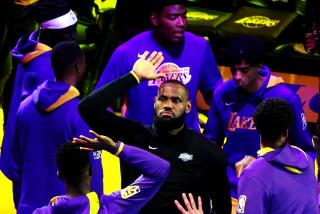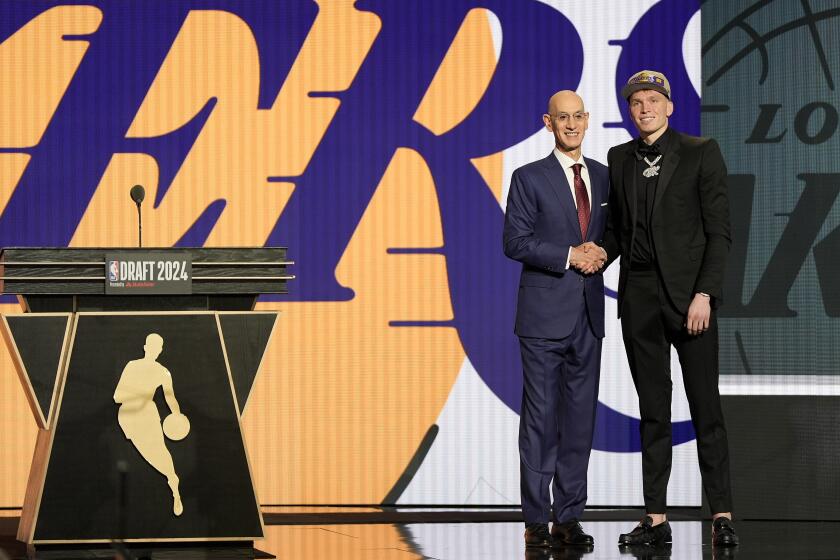Who Shot Vic Weiss? A Trail Gone Cold
The meeting with Jack Kent Cooke and Jerry Buss had gone well. Vic Weiss was close to a deal that would bring University of Nevada, Las Vegas, basketball coach Jerry Tarkanian to Los Angeles to lead the Lakers, the team Cooke was selling to Buss.
Briefcase in hand, the stocky but energetic Weiss, a 51-year-old sports promoter, sometime agent and businessman, left the meeting room at a Beverly Hills hotel, hopped into his Rolls-Royce and headed over the hill to his house in Encino.
But Weiss never made it home. Three days later, on June 17, 1979, his red-and-white Rolls-Royce was spotted in the garage of a North Hollywood hotel.
Police opened the trunk and there was the body of Victor J. Weiss, hands tied behind his back. He had been killed with two gunshots to the head.
Organized Crime Link
Ten years later, Weiss’ killing remains unsolved and one of the San Fernando Valley’s most puzzling mysteries. Los Angeles police believe Weiss was the victim of an organized crime hit, the most difficult of murder cases to crack.
It is a case that plunged detectives into the milieu of mobsters and informants, where they became suspicious of everyone, sometimes even fellow cops. And once they even found themselves being followed by someone they were investigating.
Still, they were able to learn much about the secret life of Vic Weiss. They learned that while he publicly hobnobbed with legitimate names in sports and business, he privately rubbed shoulders with criminals, ran up huge debts on sports betting and skimmed off the top of laundered money he delivered to mobsters in Las Vegas.
It is believed by police that those latter indiscretions cost Weiss his life. But who ordered the killing and who carried it out remain unknown.
Detective Leroy Orozco, the only original investigator still assigned to the killing, says that after 21 years as a homicide detective, the Weiss case tantalizes him most. He has followed leads across the country but never made an arrest. He has carefully investigated and traced potential suspects, only to learn that, apparently by grim coincidence, they too had been killed.
Orozco has two file drawers filled with reports, notes and evidence on the case to show for a decade of investigation. But even after 10 years, he doesn’t need to open the boxes to recall the details. He can even recall what he was doing--driving his family to an ice cream parlor after a Father’s Day dinner--when his electronic pager beeped and he was called to the parking garage in North Hollywood.
“This case has been my biggest challenge,” Orozco said. “It won’t lie down and die.
“You get a case like this maybe once in a lifetime. How often do you read about a Mafia hit, especially in L.A., with the intrigue of Vegas and the cops being followed by the bad guys? But I knew from the beginning it would be tough. As soon as I walked into that garage and saw that Rolls, I knew I was in deep.”
In life, Vic Weiss presented the image of success. Raised in the Pasadena area--where he went to high school with longtime friend Tarkanian--Weiss first became successful in real estate and insurance ventures and was later known as a part-owner in Ford and Rolls-Royce dealerships in Van Nuys. His red-and-white Rolls had a gold interior. He wore a diamond ring and a Rolex watch. He was known as a guy who always picked up the tab after dinner or drinks with friends and business associates.
Sports Negotiations a Hobby
Weiss became prominent in sports circles beginning in 1973 when he bought the contract of welterweight boxing contender Armando Muniz. Though not a professional sports agent, Weiss handled contract negotiations for his friend Tarkanian as a hobby. It was that hobby that brought him to the negotiating table with Cooke and Buss at the Beverly Comstock Hotel on June 14, 1979.
According to police accounts of the meeting, details of the agreement to bring Tarkanian to the Lakers were written by Weiss and Cooke on a piece of paper that Weiss dropped into his briefcase when he left.
“He was probably confident as he left,” Orozco says. “Negotiations went well.”
Weiss was to go to dinner with his wife, Rose, but first, police say, he planned to call Tarkanian, who was waiting at a Long Beach hotel for word on the negotiations. Tarkanian never got the call, and the talks would never go further. The Lakers eventually hired another coach.
Weiss was reported missing by his wife, but there was no sign of him until four days later when a security guard spotted his Rolls in the garage of the Sheraton Universal hotel. After Weiss’ decomposed body was discovered and removed, detectives found no clues to what had happened.
Weiss’ wallet and briefcase were gone, but his diamond ring and watch had not been taken. That led police to rule out robbery as a motive. Cooke, Buss and Tarkanian were quickly eliminated as having any involvement. That left police with the mystery.
But the Rolls-Royce, though clean of evidence, generated a lead in the case. Several people who had learned of the slaying in the media called police and said they remembered seeing the distinctive car on the day Weiss disappeared, Orozco says. Through these witnesses, police were able to chart Weiss’ path from Beverly Hills along Beverly Glen Boulevard to Ventura Boulevard and west into Encino.
Mysterious Tall Man
A witness told police that he had seen the Rolls pull to the curb on a street in Encino and a white Cadillac with three men in it stop behind. The witness said Weiss got out of his car and two men--one described as a 6-foot, 6-inch blond--got out of the Cadillac.
The witness said the blond man angrily pointed a finger in Weiss’ face as he spoke to him. After a few moments, Weiss got back in his car, the blond man got in the back seat behind him and the third man got in the front. Then the Rolls and the Cadillac drove away.
As detectives delved into Weiss’ background, they became confident that the witness had seen Weiss’ killers. They learned that Weiss maintained a life style that belied his true financial worth. They learned that many of his associates were involved in organized crime.
Orozco says that Weiss had no financial interest in the car dealerships he reportedly owned; he was merely a paid consultant or promotions man. An associate owned the house where he lived in Encino, and his Rolls-Royce was leased.
“When he died, he had some insurance; that was about it,” Orozco says.
Police also began receiving reports from anonymous callers, organized crime informants and Las Vegas law-enforcement officers that Weiss was involved with mobsters in Nevada and Florida. The informants said Weiss had run up gambling debts.
Mob-Style Hit
The information convinced police that Weiss had been kidnaped by the three men in the Cadillac and executed in a mob-style hit.
Orozco says he and his partner, John Helvin, traced one of Weiss’ close friends to central Florida, where he had moved immediately after the killing and worked as a car salesman. In exchange for his anonymity, the salesman told the detectives that he knew that Weiss had run up more than $60,000 in gambling debts in Las Vegas. To make good on the debts, he had begun flying to Las Vegas and delivering packages of cash laundered in Los Angeles, Orozco says.
Each week, the money came in a brown paper package and was placed in the trunk of Weiss’ Rolls-Royce, the salesman said. Weiss would then fly to Las Vegas and back on the same day. But, the salesman said, Weiss was skimming--stealing money from the deliveries--and had been caught and warned to stop.
Orozco says detectives theorized that Weiss had not heeded the warning and was killed. They began tracking the phone records of Weiss and some of his associates. They documented connections to organized crime figures and went to Las Vegas and New Port Richey, Fla., to serve search warrants on the homes of people believed associated with the killing.
Search Fails
In Las Vegas, the detectives got a search warrant from local authorities, but the house they planned to search was empty on the morning they arrived. Orozco speculated that the suspect had been tipped off and moved out.
In New Port Richey, things also went poorly.
Orozco and Helvin arrived late one afternoon and drove by the house, which they planned to search the next day after obtaining a warrant from local authorities. The house belonged to a man suspected of being an “enforcer” with an organized crime family, Orozco says. The detectives noticed a boat in the canal out back and a black Camaro parked in front, indicating that the occupants had not been tipped to the search and were still living there.
The next morning, Orozco says, he glanced out the window of his motel room and saw the same black Camaro in a parking lot across a canal next to the motel. A man was sitting behind the wheel of the car, watching the motel.
“We flipped a coin to see who’d go out the door first,” Orozco says.
Helvin lost. They drew their weapons and with Orozco covering, Helvin quickly went down to the lobby. Orozco followed, but by the time they got into a rental car, the black Camaro was gone.
Orozco says he and his partner were turned down for the search warrant because they did not have enough evidence that the suspected enforcer had been involved in the Weiss killing.
Orozco says he was paranoid when he returned to Los Angeles.
Not knowing how information about their movements had gotten to the targets of the investigation, he and Helvin stopped talking about the case to some officers inside and outside the department. Orozco says that when a retired Los Angeles detective inquired about the case, he gave the man false information. A few days later, Orozco says, an organized crime informant called with the same wrong information.
“We didn’t talk to anyone after that,” Orozco says. “We just came in, did our work and went home. If I went out of town on the case, I only told my lieutenant.”
Orozco and Helvin continued to work full time on the Weiss killing for two years. At least three men they investigated would become the victims of apparently unrelated slayings.
Jewel Thief
One of them was Jeffrey Rockman, whose name was found on a piece of paper in Weiss’ office. Police learned that Rockman, 33, was a jewel thief who worked for a Canadian organized crime syndicate and was believed to have sold stolen property to Weiss.
But police did not find Rockman in time to question him about the killing. On April 29, 1980, he was shot to death in his Marina del Rey townhouse. Orozco says detectives learned that Rockman’s real name was Anthony Starr and that he had been given the new identity after entering the federal witness-protection program when he testified in a Detroit bank robbery case. Police believe his killing was unrelated to the Weiss case.
Ronald Launius was another thief, and a drug dealer, who police learned had associated with Weiss. Though he was investigated, there was never any evidence to connect him to the slaying.
On July 1, 1981, Launius, 37, was one of four people beaten to death in a Laurel Canyon drug den. A former Hollywood nightclub owner and his bodyguard were charged last year with killing the victims in revenge for a robbery.
Orozco says Launius earlier had been associated with Horace McKenna, a former California Highway Patrol officer who operated a string of bars featuring nude dancers. McKenna was believed by police to have ties to prostitution, counterfeiting, narcotics and gambling in the Los Angeles area.
Investigators in the Weiss case attempted to learn whether McKenna was connected to the Weiss killing but never were able to establish that the two men knew each other. McKenna was killed March 9 at the gate of his Orange County estate when a gunman fired a machine gun into the back of the limousine in which he was riding. The slaying remains unsolved.
Through the years, names contained in Weiss case files have often come up in unrelated cases, Orozco says. But detectives have never put a name on the tall blond man. Although a mob informant once told police that the men who killed Weiss were themselves killed to maintain organized crime’s veil of silence, Orozco believes the killers may still be alive and free.
Helvin has retired and Orozco handles other cases. But he still gets calls from informants offering street information on the Weiss killing. And sometimes he hears from law officers who have heard of the case in the course of other investigations.
“In other unsolved cases you usually hit the wall, where you’ve exhausted your investigation and you put it away,” he says. “This one isn’t like that. You can put it away but it keeps coming back.”
Orozco occasionally drives the same route Vic Weiss took on his last ride. He is waiting for the piece of data that will lead to an arrest, or the name of the blond man.
“Somebody will have to get jammed up, arrested on something else, and want to give us some help,” he says wistfully.
More to Read
All things Lakers, all the time.
Get all the Lakers news you need in Dan Woike's weekly newsletter.
You may occasionally receive promotional content from the Los Angeles Times.






